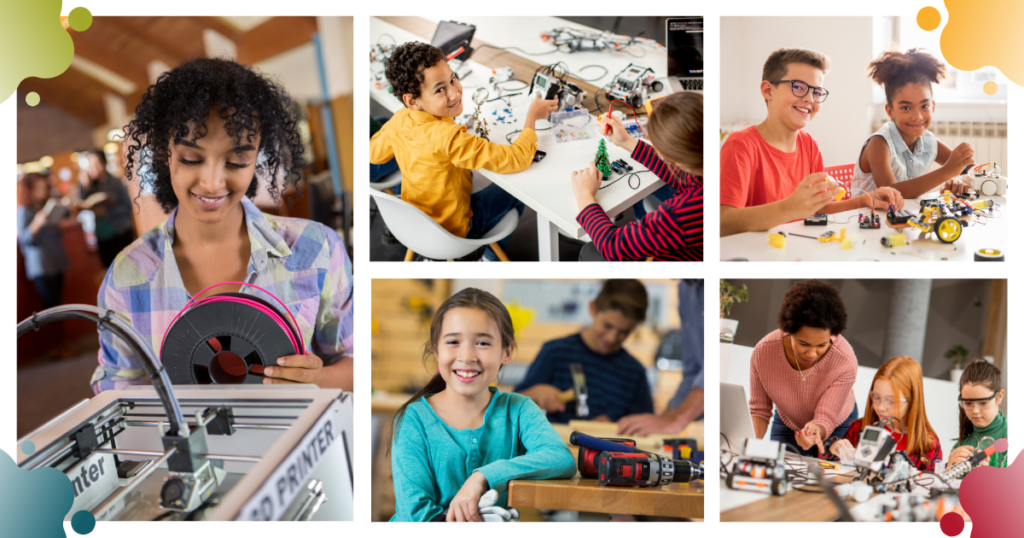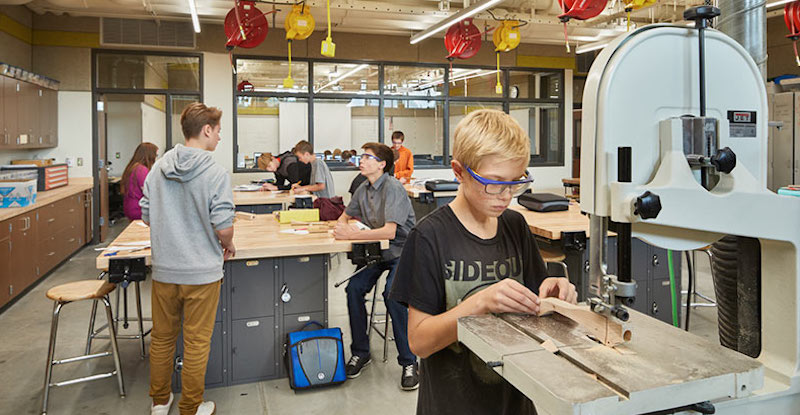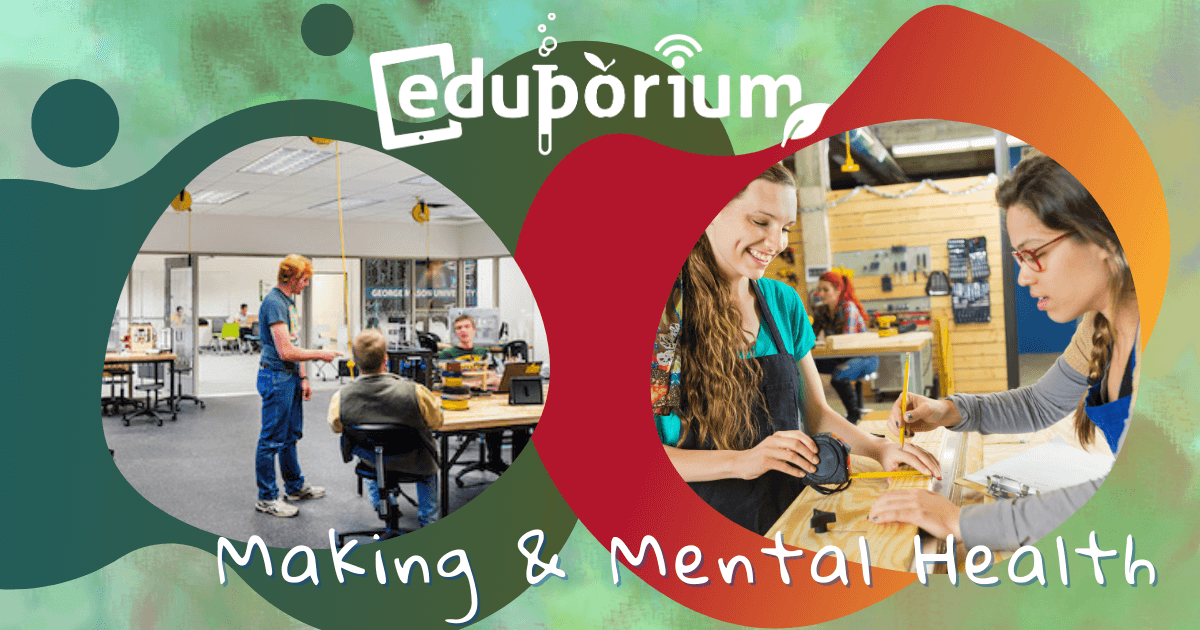Makerspaces and the educational experiences they help foster can create invaluable opportunities for kids and their academic development. They can also bolster a lot of relevant intellectual and interpersonal skills, like creativity, problem solving, collaboration, and communication when they work together on really unique projects. Maker education, however, isn't limited to academic development or learning within your library. A large part of it also ties in with social-emotional skills development for children. SEL remains a hot topic around the K-12 community and the connection between making and mental health is also prominent. That connection also has a legitimate place in learning as teachers use makerspaces for education and SEL.
Meeting SEL Needs in School Makerspaces
When designing a makerspace and plans for student use, intentional measures can help connect mental and emotional experiences to physical learning. Teachers can usually recognize when a student's emotions are off, which is very important. Recent negative experiences in their home or social lives can directly affect their academic performance. In fact, anxiety and depression cases were already on the rise in K-12 schools before the pandemic. Factor in everything that's happened since and teachers are focusing much more on addressing mental health through positive, hands-on learning experiences. A nice place to start is simply by weaving social and emotional themes into lessons. They might touch on effective communication, anger management, self-efficacy, and more but this is just the start. And, as we all know, some of these students need social and emotional support on a larger level.
How makerspaces help improve mental health.
Teachers might need guidance on how to recognize and address certain problematic behaviors. Of course, some of these behaviors are fairly obvious to recognize. Some other indicators of social-emotional deficits, however, are more difficult to pinpoint. SEL training, for example, can help educators determine when they should step in and speak to kids regarding their mental state. Then, there is the makerspace side of things. Though it might not seem like it at first glance, makerspace experiences can have great effects on students who are struggling emotionally. When educators identify students who might benefit from new approaches, suggesting they try out some makerspace projects is a great idea. And, while teachers might take SEL into consideration when designing a school makerspace, they don't need anything all that in-depth. It’s more about using traditional MakerEd tools in a new way—sometimes even in the school library.
Supplementing classroom learning in the makerspace.
Social-emotional factors come into play as a byproduct of academic experiences and being around peers. In a makerspace, students can work at their own pace and, while they’re working on something academic most of the time, they can connect with these projects in new ways—bolstering mental strength and SEL skills. Essentially, makerspace learning provides benefits beyond the academic ones. School leaders can also create or repurpose a makerspace area if addressing social and emotional concerns is your priority. If students are experiencing academic, emotional, or personal difficulties, for example, putting them aside and working on making something can alleviate stress—even if it’s only temporary. Thinking of this space like a library—allowing students to borrow materials, work with them as long as they’d like, and then head out—is one way to start. Plus, it doesn't necessarily require any expensive equipment.
The Relationship Between Makerspaces and Student Wellbeing
At the core of makerspace learning is how the activities—while still educational—allow students to relax and have fun. There is no definitive makerspace definition and many school makerspace projects are self-designed—often born out of student passions. Students can also often see what it is like to fail at making something the first time around as well as how they may assess what went wrong and apply that insight to either their next attempt at the same project or their next attempt at making. When they eventually see how they can make things work in the makerspace, they’re able to build more confidence. They could then take this confidence with them into all areas of their academics and use it as a pillar. And, this often helps keep them focused, positive, and excited about hands-on learning.
Focusing on student wellbeing.
The relationship between making and student wellbeing is rooted in constructionism, which has historically been tied to the Maker Movement. Wellbeing is the degree to which a student is effectively functioning as a member of the school's community in academic and social situations. Research on students consistently shows they achieve more academically when they have greater wellbeing, which includes enhanced mental health and the opportunity for social growth—the latter of which is a main element of makerspaces. If any students begin feeling too much pressure in their everyday lives, they may tend to shut down. Letting them try makerspace projects, however, can help them reset and regain the proper mindset.
Evaluating student wellbeing in makerspaces.
When a makerspace embodies the characteristics of a welcoming environment, students tend to feel more comfortable exploring new projects and makerspace ideas. They could use technology as well as non-tech items to invent and build while feeling relaxed. When teachers see students expressing joy and excitement while making, that is the No. 1 indicator of student wellbeing. Educators might also value students sharing their makerspace projects with a larger community, like the whole school or town. Receiving praise from others, including others they do not know personally, can help validate their efforts and boost self-esteem. And, with that boost in self-esteem comes greater levels of confidence, wellbeing, and mental health.

Makerspace Learning and Emotions
As just about every contemporary educator can attest, the efforts school leaders are making these days to address and curb mental health issues among students are ramping up. No teacher wants their instruction, attitudes, inability to foster meaningful relationships, or excessive screen time to contribute to any student unhappiness, especially if they were already triggered by something outside their control. At the top of the mental health initiatives many administrators implement and promote is their attempt to end bullying. This includes bullying that takes place in the school, on the playground, or online. Fortunately, knowing how to properly handle these kinds of situations gets easier for teachers over time. But, for educators who don’t see them arise all that often, they might not know how to best approach them.
Managing emotions in makerspaces.
You may be wondering about the subtle connections between a school makerspace and students getting bullied. Many kids and adults find comfort in visiting libraries and finding books that have a real meaning to them. Since many school makerspaces are in the library, we think it's appropriate to make this comparison. When fully engaged in a makerspace project—whether designing something for a specific purpose, just to give it a try, or, in this case, simply as a distraction—students tend to better engage in their making journey. They also start exploring dozens of potential approaches to making their project perfect and personal. This can help redirect feelings of anger, sadness, or discouragement they had before entering the makerspace. And, some might even channel their emotions into deciding what kinds of projects to create.
Healing and growing from past traumas.
Students could also use any past negative experiences in makerspace projects. Say they’ve experienced bullying previously, for example. One student or a group can work on a mural or sculpture for a school- or district-wide anti-bullying campaign. Making is one powerful vehicle for expression and publicly displaying such a project for teachers and, more importantly, students to see can be eye-opening. This also can help students address any pain or other feelings they have towards things that negatively affect them. After all, we should be aiming to identify these mental and emotional conflicts in all K-12 students. Whether they'll ultimately want to try working in the makerspace as a solution or not, teachers sometimes need to step in and get them back on the right track both academically and in their personal lives.
The Various Purposes of Makerspaces
One of the words we use to best describe makerspaces as a whole is versatile. They offer a lot of different benefits and rewards for students across every grade (or for adults outside education), including academic, social, intellectual, and emotional boosts. Makerspaces also often help maintain or deepen the impact that campus libraries have in schools and colleges. Though many view libraries as a fading entity thanks to this digitalization of materials, some more resourceful educators have learned to capitalize on this rather than running from it. If students want digitalization, they still can still get it from makerspace technologies. And, this is a perfect example of how the balance in these spaces has evolved to best serve students.
Tangible and intangible benefits of makerspaces.
The value that each makerspace provides for students also includes a ton of variance. Some students gain a variety of new skills and insights through their makerspace experiences and carry them into all their other classes. Others might just find that the makerspace provides them with a more social experience during or after school. It is really difficult to measure which of these benefits are ultimately the most impactful but all educators—especially administrators—like to be able to quantify various benefits of makerspaces, though that’s easier said than done. Plus, in our opinion, that's not really why makerspaces exist. Ultimately, kids tend to crave makerspace experiences and school leaders can help create them by repurposing school libraries with some maker equipment that students can create with.
Promoting student wellness in the school community.
Then, there’s the wellness portion of school libraries and makerspaces. As we’ve said, educators are aware that kids are dealing with anxiety related to academics, home lives, and post-pandemic experiences. Some educators experiment with this but it often means that faculty shifts around and have to master new things, like replacing the school librarian with the school psychologist, for example, which would be tough for both parties. Though makerspaces can help alleviate a bit of student anxiety, it’s not really imperative that every administrator navigates toward this. Some might need to dig deeper to find the source of this anxiety and perhaps alter other in-school elements. It all comes back to being versatile and using the space you have to meet student needs.

Making to Achieve Mental Health
A lot of the time, if teachers are discussing the social, emotional, and well-being benefits makerspaces can provide, it’s because they noticed some students having issues and are looking to address them. This does not always, however, have to be the case. Teachers can absolutely look to create makerspace experiences that are more pre-emptive as opposed to reactive. Perhaps, in these cases, the experiences students have can help curb any potential emotional problems. It would also allow them to maintain strong mental health throughout the school day and year. Now, you might be thinking this simply means opening a makerspace within the school and, while that's probably the first step, you can still build that makerspace with careful consideration and with student well-being in mind.
Creating new experiences for students.
Teachers and mental health professionals both believe that opportunities to create in a hands-on way helps combat some of the negative effects mental health can have on academic performance. Children may have also become unhappy while being stuck home, reading from a textbook, or from long video calls. This also, however, doesn’t necessarily take a traumatic event for their mental health to decrease. The simple acts of repeating the same experience day after day can take a toll. This is not the ultimate makerspace guide but mixing it up and affording them the freedom to get creative in a makerspace environment can help flip a switch in their brain that stimulates academic creativity and emotions in positive ways. And today, student mental health is erratic following the pandemic, so having a place to work on that can help.
Translating makerspace experiences to general development.
One strategy teachers can use in a makerspace is constantly supporting students. We recently read about one example of a student noticing some large chunks of wood from a cut tree nearby. She told her teacher and, without thinking, he headed out to help her carry them in. Does it matter that it was messy and took a bit of time? Will it matter that the project itself probably took up some time to complete? Or, does it matter that additional equipment would probably also need to be involved? No, at least not to this teacher, which is a fantastic example of putting student mental health first. If their teacher tried to talk this student out of gathering wood, she may have become discouraged, thought her idea wasn’t good, and might no longer voice project ideas. But, he didn’t do that and, instead, he created a positive student experience.
If you have a vision for creating a makerspace inside your school or library, we would love to help. To get in touch with our experts for guidance on budget constraints, STEM tool selection, creating SEL connections, or the design process, click the banner below. For all the latest EdTech, STEM, and 21st century education news, follow Eduporium on Twitter and Instagram, like us on Facebook, or sign up for our newsletter for our latest product offerings. If you have an idea for an Eduporium Weekly theme, send our team a message on social or comment below.





2 Comments